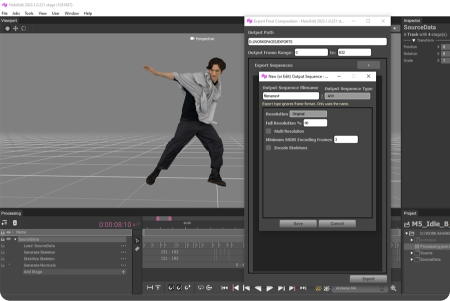In this blog post, we will explore the differences between OMS and AVV and discuss the scenarios where each excels.
OMS: Optimized Mesh Sequence
Included in HoloSuite’s annual license is Optimized Mesh Sequence (OMS) while Accelerated Volumetric Video (AVV) is available as a premium add-on. Both serve distinct purposes, and understanding their differences is helpful in selecting the appropriate export for your specific project. In this blog post, we will explore the differences between OMS and AVV and discuss the scenarios where each excels.
OMS is a compressed file format optimized for volumetric playback. It contains mesh data and supports skeletal data for retargeting. OMS was designed with the objective of efficient data transmission and rendering, making it an ideal choice for streaming applications. OMS performs exceptionally well in situations where network resources are limited or constrained, as it will allow for smooth and uninterrupted streaming experiences. It finds great utility in applications such as video streaming platforms, where bandwidth limitations are a primary concern. If you’re working in mobile applications OMS is the export of choice. Given the restricted computational power and potential limitations of mobile devices, OMS employs optimization techniques that ensure the efficient delivery and rendering of mesh data. If you’re working around a disk space limitation, the OMS format produces significantly smaller file sizes. Or if you’re looking to retarget the limbs or head, you’ll need to utilize OMS.
Exporting your volumetric data as an OMS is included in the HoloSuite annual subscription.
AVV: Accelerated Volumetric Video
AVV, or Accelerated Volumetric Video, is a larger file format meant to store high-quality mesh and texture information and have a lower cost in decoding. This format shines in scenarios demanding real-time playback for large-scale scenes with numerous volumetric capture (volCap) actors while retaining fidelity in each actor. It is the preferred choice for high-end desktop applications that necessitate a higher level of detail and performance. In such applications, the preservation of facial mesh and texture details is critical to maintaining a realistic and immersive experience.
AVV ensures real-time playback without compromising on quality or fidelity. It enables high-end desktop applications to maintain the desired level of realism and detail even when dealing with large-scale scenes in Unreal or Unity. Exporting your volumetric data as AVV export is a premium feature that can be purchased with your HoloSuite license.
Choosing the right export
When deciding between OMS and AVV, it is important to consider both the power of your hardware and specific requirements of your end application. If you are working with limited bandwidth conditions or developing a mobile application that demands efficient streaming, OMS is likely the better choice. On the other hand, if you are dealing with large-scale scenes that require real-time playback for numerous volCap actors, or if preserving intricate face mesh and texture details is crucial, AVV would be the more suitable export.
By understanding the strengths and ideal use cases of each format, you can make an informed decision about which one to employ in your specific application, ensuring optimal performance and user satisfaction.
Contact us to learn more
Our team is ready to answer any additional questions you may have. If you’re a new customer evaluating which version of HoloSuite you require, you can contact our sales team for more information. If you're an existing customer considering upgrading to a premium license, you can contact our Success team through the Support Portal in HoloSuite.
